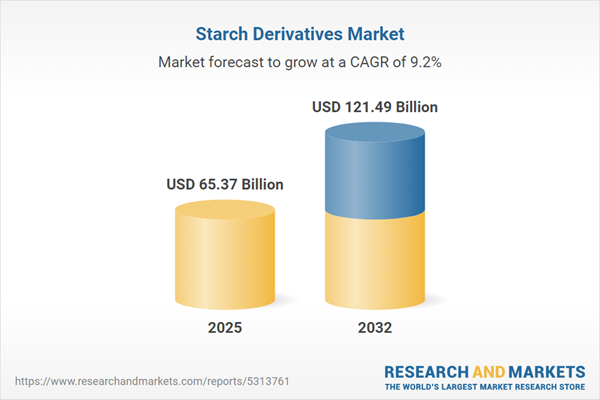Speak directly to the analyst to clarify any post sales queries you may have.
Senior executives in the starch derivatives market are navigating a transformative era marked by evolving consumer expectations, regulatory change, and advancements in processing technologies. To maintain a competitive edge, leaders require real-time, actionable intelligence tailored to their unique market and operational challenges.
Market Snapshot: Starch Derivatives Market Growth and Outlook
In 2024, the starch derivatives market reached USD 59.93 billion and is projected to achieve USD 121.49 billion by 2032, reflecting a robust CAGR of 9.23%. Market momentum is driven by technological breakthroughs, increased adoption of clean label products, and the widespread application of starch derivatives across critical industries, including food and beverage, pharmaceuticals, and industrial manufacturing. Stakeholders are adapting to heightened supply chain expectations through updated operational frameworks, while expanding product portfolios offer new regional opportunities and avenues for differentiation.
Scope & Segmentation of the Starch Derivatives Market
This report empowers senior decision-makers with granular insights for managing risk, optimizing growth strategy, and maximizing value creation. The analysis covers a broad array of industry dimensions:
- Applications: Encompasses segments such as animal feed, baking, beverages, confectionery, dairy, sauces, industrial paper, packaging, pharmaceuticals, textiles, and personal care, demonstrating the market’s broad commercial relevance.
- Product Types: Includes dextrin (white and yellow), maltodextrin (diverse DE ranges), acid-modified, cross-linked and oxidized starches, along with resistant variants, ensuring adaptability to end-use specifications.
- Source Materials: Assesses primary inputs—cassava, corn, potato, wheat—underscoring supply flexibility and notable regional production strengths.
- Functionality: Reviews binder, emulsifier, fat replacer, stabilizer, and thickener roles, in response to shifting customer demand for functional and adaptive formulations.
- Physical Form: Examines powder and liquid formats, highlighting the implications for manufacturing efficiency, storage, and distribution logistics.
- Regions: Analyzes perspectives from the Americas, Europe, Middle East & Africa, Asia-Pacific, while focusing on high-growth countries including China, India, Japan, Australia, and Southeast Asia to support expansion planning.
- Companies: Provides profiles and benchmarks for key players such as Ingredion Incorporated, Tate & Lyle PLC, Cargill Incorporated, Archer-Daniels-Midland Company, Roquette Frères S.A., Tereos SCA, Royal Avebe U.A., AGRANA Beteiligungs-AG, Emsland-Stärke GmbH, and Grain Processing Corporation, supporting industry benchmarking and partnership evaluation.
Key Takeaways for Senior Executives
- Manufacturers are introducing multifunctional and clean label starch derivatives to meet brand and private label demands for plant-based and transparent product options, enhancing market positioning.
- Progress in enzymatic processing and adoption of green chemistry fuels growth in pharmaceuticals and personal care, where supplier selection hinges on enhanced product performance and safety.
- A strategic shift toward sustainability is visible through investments in energy-efficient, resource-saving processes and circular business models, mirroring the environmental priorities of buyers.
- Collaboration between brands and suppliers is accelerating the launch of specialty and value-added derivatives, reducing time to market for product innovations.
- Digital traceability is empowering suppliers by improving ingredient transparency, thus facilitating ongoing regulatory compliance and enhancing competitive advantage.
- Regulatory pressures in core regions elevate the importance of operational agility and local market expertise to address labeling requirements and maintain cost competitiveness.
Tariff Impact: Navigating U.S. Tariffs and Compliance Challenges
The impending introduction of new U.S. tariffs on imported starch derivatives in 2025 is prompting firms to re-evaluate sourcing models and renegotiate supplier agreements. Leading companies are diversifying procurement channels and raising compliance standards, thereby reinforcing supply chain resilience to manage regulatory shifts and mitigate supply volatility. This environment demands agile contractual and operational approaches for sustained value creation.
Methodology & Data Sources
This analysis combines comprehensive secondary research—spanning trade literature, regulatory records, and sectoral reports—with direct interviews of industry specialists. Findings are rigorously triangulated to provide reliable, actionable insights for executive strategy and planning.
Why This Report Matters
- Offers detailed, segment-level analysis aligned with regulatory, technology, and geographic priorities, guiding senior leaders toward data-driven decisions in a dynamic market environment.
- Supports thorough risk evaluation and strategic portfolio management, facilitating effective entry and value maximization in diverse international segments.
- Delivers trusted recommendations to enhance supply chain robustness and sustainable, long-term compliance with evolving industry regulations.
Conclusion
With data-led insight and adaptable strategies, senior executives are equipped to navigate complex market shifts. Investing in advanced technology and forward-thinking regulatory responses will unlock new growth opportunities and foster sustained market relevance.
Additional Product Information:
- Purchase of this report includes 1 year online access with quarterly updates.
- This report can be updated on request. Please contact our Customer Experience team using the Ask a Question widget on our website.
Table of Contents
3. Executive Summary
4. Market Overview
7. Cumulative Impact of Artificial Intelligence 2025
Companies Mentioned
The companies profiled in this Starch Derivatives market report include:- Ingredion Incorporated
- Tate & Lyle PLC
- Cargill, Incorporated
- Archer-Daniels-Midland Company
- Roquette Frères S.A.
- Tereos SCA
- Royal Avebe U.A.
- AGRANA Beteiligungs-AG
- Emsland-Stärke GmbH
- Grain Processing Corporation
Table Information
| Report Attribute | Details |
|---|---|
| No. of Pages | 181 |
| Published | October 2025 |
| Forecast Period | 2025 - 2032 |
| Estimated Market Value ( USD | $ 65.37 Billion |
| Forecasted Market Value ( USD | $ 121.49 Billion |
| Compound Annual Growth Rate | 9.2% |
| Regions Covered | Global |
| No. of Companies Mentioned | 11 |









